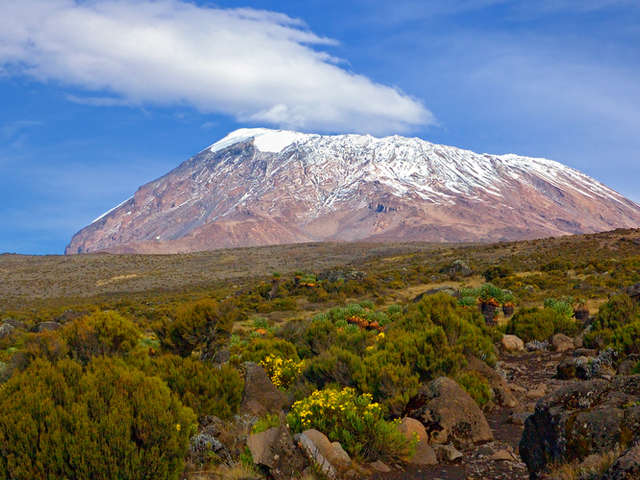6 Days Rongai Route Mount Kilimanjaro Climb, Overview, Itinerary and FAQs
Overview:
The Rongai Route is a lesser-travelled route that approaches Kilimanjaro from the north, near the Kenyan border. It is known for its beautiful scenery, solitude, and gradual ascent, making it a popular option for those seeking a longer and more relaxed climb. The climb typically takes six to seven days, with a high success rate of reaching the summit.
Here are some frequently asked questions about this route:
The Rongai Route is known to have a higher success rate than the other routes due to its gradual ascent and longer acclimatization time. The average success rate is around 85%.
It is recommended to have certain vaccinations such as tetanus, hepatitis A, typhoid, and yellow fever. It’s best to talk to your doctor or consult a travel clinic about the required vaccinations before traveling to Tanzania.
The best time to climb Mount Kilimanjaro is during the dry season, which runs from June to October, and December to February. The weather conditions during these months are stable, with clear skies.
Yes, you need a permit to climb Mount Kilimanjaro, which you can obtain through a licensed tour operator. Permits are limited, so it’s essential to book in advance.
You will need proper hiking gear like waterproof hiking boots, warm clothes, gaiters, warm gloves, hats, sunglasses, and a waterproof jacket. A sleeping bag, trekking poles, and a good backpack with a hydration pack are also recommended. It’s best to check with your tour provider for the complete gear list before your climb.
Day by Day Itinerary
Day 1: Nalemuru Gate to Simba Camp
– Elevation (ft): 6,398 ft to 8,563 ft
– Elevation (m): 1,950 m to 2,610 m
– Hiking time: 3-4 hours
After breakfast in Moshi, drive to the trailhead at Nalemuru Gate. After registering with the authorities, begin hiking through farmland and pine forest until you reach your camp for the night at Simba Camp.

Day 2: Simba Camp to Kikelelwa Camp
– Elevation (ft): 8,563 ft to 11,811 ft
– Elevation (m): 2,610 m to 3,600 m
– Hiking time: 6-8 hours
Today’s trek is mostly uphill as you continue through scenic heathland and moorland until you reach Kikelelwa Camp.

Day 3: Kikelelwa Camp to Mawenzi Tarn Camp
– Elevation (ft): 11,811 ft to 14,160 ft
– Elevation (m): 3,600 m to 4,315 m
– Hiking time: 3-4 hours
Today’s hike is shorter but more challenging as you cross the lunar desert and reach Mawenzi Tarn camp, located at the base of Mawenzi Peak.

Day 4: Mawenzi Tarn to Kibo Hut
– Elevation (ft): 14,160 ft to 15,430 ft
– Elevation (m): 4,315 m to 4,700 m
– Hiking time: 4-5 hours
Hike across the Saddle, a rocky wilderness, to reach Kibo Hut – your basecamp for the summit attempt.

Day 5: Kibo Hut to Uhuru Peak and Horombo Hut
– Elevation (ft): 15,430 ft to 19,341 ft (peak), then to 12,100 ft (Horombo Hut)
– Elevation (m): 4,700 m to 5,895 m (peak), then to 3,700 m (Horombo Hut)
– Hiking time: 6-8 hours to Uhuru Peak, then 6-8 hours to Horombo Hut
Begin the summit attempt at midnight, reaching Gilman’s Point at dawn and Uhuru Peak soon after. Descend back to Kibo Hut for rest and refreshment before continuing on to Horombo Hut for the night.

Day 6: Horombo Hut to Marangu Gate
– Elevation (ft): 12,100 ft to 6,398 ft
– Elevation (m): 3,700 m to 1,950 m
– Hiking time: 5-7 hours
Descend through the rainforest to Marangu Gate, where you will receive your summit certificates before transferring back to your hotel in Moshi.

